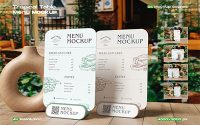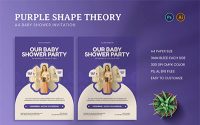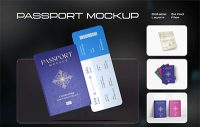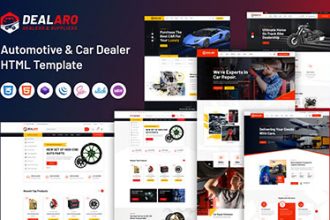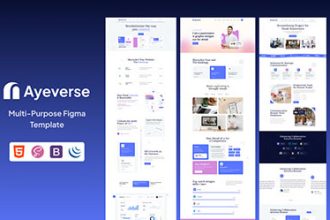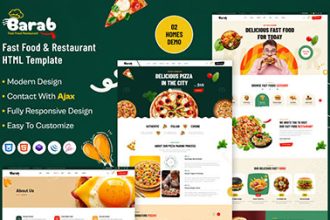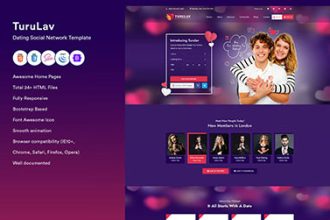Despite there are lots of content management systems that make website creation easier, lots of developers still use HTML in their work. WordPress and Drupal can make the work simpler, but coding allows to build more flexible and original page structures. It demands from you a certain level of knowledge, but achieving that level is not very complicated and there are ready-made themes that could still make the website creation process faster. So, if you are going to create a portfolio – you should do it with the help of one of the photography website templates.
What is a website template?
If to say in a plain language, I could compare the HTML website template to a photo frame you can buy in a photo equipment store. When you buy it – you only place the photo or picture inside and put it on the wall. That is exactly how the website builder templates work. The HTML theme is a set of pre-made website pages, that has design, created by professionals and all the functionalities you may need. After you purchase it – you have to download it to your hosting, insert texts and pictures – and voila! Your website is ready for launch.
Portfolio website templates are usually made stand alone and self-contained. That means that you download an independent product from the marketplace and that this product won’t need any other third party websites or software to work normally. Freshly downloaded HTML website templates don’t have any links or connections, so it has to work correctly on your computer even if it wasn’t connected to the internet.
Advantages of using website templates
Simplicity. Using template is easier than building a website from the scratch. It is almost a ready-made website you can just customize and there will be no risk forgetting about some important block or functionality.
Accessibility. After reading a few articles and tutorials an average website owner will be able to customize the HTML website template, but to create a whole site from the ground up he will need to have some good coding skills.
Clarity. If you will build the website with the code – you will probably make several mistakes. And it doesn’t matter if you wrote it thousand times already – making mistakes is normal for the big projects. So, if you use a template you’ve already checked there will be much lesser errors.
Independence. It is hard to code the whole website solely. For some really unique website projects there are big teams of developers who work together. But with a template you can do everything by yourself. You just install the website theme and do a few changes – and there it is.
How to install the HTML website template?
First of all, you will need a hosting and a domain name. Your website needs to be stored somewhere, so you have to start with providing some “space” to build it. There are lots of hosting services in the web, and some of them are completely free. I recommend you to choose carefully – hosting is very important for the website’s reliability, security and speed.
Besides the hosting and the HTML website template file you will also need an FTP client app. FTP means File Transfer Protocol and it is the way you can connect to the server your website will be stored on. The number of different FTP clients is also huge, so you will have the variants to choose from. My favorite if FileZilla program, so you can take it too. This app is the simplest and the most smoothly-working of all I know.
When all the preparations are done – the algorithm is simple:
- Open your hosting control panel ad find the FTP data: hostname, username, number of the port and password.
- Open your FTP client and enter the FTP data. Then connect to the server.
- Find on the server the folder named according to your domain name or just “public”.
- Open the HTML website template file you downloaded and unzip it. Find a “HTML” folder there and copy all the files stored there.
- Drag-and-drop all the files from HTML folder to the directory on the hosting.
- Go to your browser and type your domain name into the bar. Voila! The HTML theme is installed to the website.
What is a portfolio website?
I think you already know it, but let’s repeat once again – portfolio website is now your CV. It can contain CV, but it will obviously have more than one page. Portfolio website is a popular way to show your future employer what you`re worth. Web developers show their skills in the website’s functionalities, photographers and graphic designers create galleries of their works and copywriters manage the blog. So, if you are going not only to create a portfolio website, but also add it to the resumes and sent to clients you need it to be really awesome. The look of your portfolio website could affect the client`s decision about who to hire.
5 features that will make your portfolio rock
I would like to give you a few tips about the features that are a must for any successful portfolio website. Some of them could be really obvious, but this would be some kind of a checklist for you. This would also be not an ultimate listing, but a few features that could make you regret forgetting to use them. I will add some examples of existing HTML website templates as well, so you will have some visual clues.
Attractive and simple “About me” page
You are introducing yourself to your future employer. If you are not going to make this page impressive – why are you creating a portfolio website at all? This page is like a nice suit you take on when going for an important negotiation. According to its look, the client will evaluate you and from the first sight understands if you fit him. The most important recommendation here is: “Simply be yourself”. Don’t try to look like someone you are not – write in the simple language and add the photos of yourself you like the most, even if you are in some strange environment and bright closes.
Take a look at this “About us” page of Kelissa Smith HTML website template. Beautiful background, simple frame, great photo, and not too much text – in combination they give an astonishing effect. When you will start creating your own photographer website, try to achieve the same effect of elegant simplicity.
Portfolio, actually
That is what your client came for – the examples of your work. It doesn’t matter if that would be photos, pictures, projects of buildings, finished websites, etc. The gallery showing your works should look perfect and brilliant. However, be careful not to distract the viewer from the, actually, examples. If your gallery will be too complicated, with various animation effects and distracting background picture it will only harm.
This Personal Page HTML template’s gallery is just perfect. The red color of the background attracts attention, the photos are black & white, but become colorful on hover – this gallery grid looks elegant and accurate at the same time. It is designed so well, that will easily make the visitor stop and look at it. You need the same effect.
Understandable menu
There’s nothing more annoying for a user than a complicated menu. It has to be completely intuitively understandable and clearly shows the client how he could find something he is looking for. Avoid tricked-out menus with unusual forms and unobvious controls – nobody would be trying to get along with it, they will just leave the site. It will be really wise to make some testing before launching the site – ask your friends and relatives to try it and define is it easy to navigate through it.
The menu of Evan Robertson HTML website template will be a perfect example. Manu is structured perfectly clear and has a drop-down. You can divide all the content into understandable categories and expand it with the details in the drop-down. When seeking for a theme try to choose the one that has an equally simple menu.
Contacts page
The clearer your contacts placing will be – the better. Just imagine – your future client gets through your portfolio website, liked it and decided to hire you. And then he can’t find your contacts. Do you think he will patiently seek for it? Nope. He will just leave and find another employee because in most cases the competition is very harsh. So do your best to help the client find and hire you.
A format of a business card is one of the best solutions for a contacts page. Adam Jones HTML template has an accurate and useful contacts category. It lists all the ways the client could contact you, shows your location on the map and has a contact form that allows the employer to write to you without any additional link following or another device usage.
Mobile ready design
That is a feature no modern site can ignore. I bet even you use your smartphone to surf the internet while going to work or home. In case your client would like to seek for someone to hire via a mobile phone you have to make your portfolio look good on every type of screen. When your website adapts to the size of the device it is called “responsive design”. Make sure the theme you downloaded is responsive.
Take a look on Weboo HTML website template – it’s demo even has an option to watch how does it look like on the tablet and mobile phone screens. All the design is accurately compressed, so it looks nice and clear on the small device.
Conclusion
Creating a portfolio could be a harsh task that will take lots of your time. However, I’m concerned that you clearly understand the importance of a good impression on the employer. The profit and numerous clients will be worth every second you spend polishing the appearance and usability. Good luck with building a breathtaking portfolio website and getting a great job offer!

